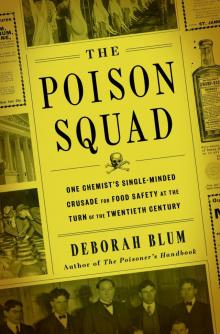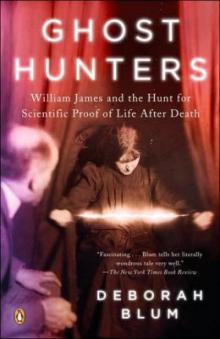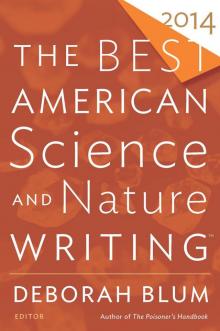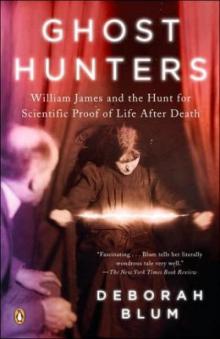- Home
- Deborah Blum
Love at Goon Park: Harry Harlow and the Science of Affection
Love at Goon Park: Harry Harlow and the Science of Affection Read online
Table of Contents
Praise
OTHER BOOKS BY DEBORAH BLUM
Title Page
Dedication
Introduction
Acknowledgements
PROLOGUE
ONE - The Invention of Harry Harlow
TWO - Untouched by Human Hands
THREE - The Alpha Male
FOUR - The Curiosity Box
FIVE - The Nature of Love
SIX - The Perfect Mother
SEVEN - Chains of Love
EIGHT - The Baby in the Box
NINE - Cold Hearts and Warm Shoulders
TEN - Love Lessons
EPILOGUE - Extreme Love
Notes
Index
Copyright Page
Praise for Love at Goon Park
“In her 1994 book, The Monkey Wars, Pulitzer Prize–winning journalist Deborah Blum superbly balanced opposing views of the incendiary issue of primate vivisection. In Love at Goon Park, Blum does an equally skillful job balancing the pictures of that psychologist, Harry Harlow, as troubled soul and brutal abuser of his experimental subjects versus helper of humankind through brilliant science.... Blum does the excellent, requisite historian’s job, illuminating a period whose zeitgeist differs from ours.... It’s an irresistible story told exceedingly well.”
—Robert Sapolsky, from Scientific American
“Blum’s valuable book is sometimes enchanting and sometimes poignant, but always interesting. It shows the reality behind the simplistic stereotypes that have often been associated with this brilliant and troubled genius.”
—Duane M. Rumbaugh, Ph.D.,
The New England Journal of Medicine
“Pulitzer Prize–winning journalist Blum (The Monkey Wars) rivetingly recounts Harlow’s work while examining the man himself.... Blum’s excellent biography, the first major new work devoted to him, should change that. Highly recommended for public and academic libraries.”
—Library Journal
“Blum integrates clear explanations of the theories Harlow was reacting against (such as behaviorism) with details about his fractured home and personal life. An informative, candid biography.”
—Booklist
“In this surprisingly compelling book, Blum (The Monkey Wars) reveals that many of the child-rearing truths we now take for granted—infants need parental attention; physical contact is related to emotional growth and cognitive development—were shunned by the psychological community of the 1950s. . . . Monkey Wars fans who have been waiting for a follow-up will find this book irresistible.”
—Publishers Weekly
“For generations of psychology students, the image of a baby monkey being comforted by a cloth doll is one of their most indelible memories of the subject. Yet even most psychologists know little about the brilliant, funny, and infuriating man behind the experiments. Nor do many people know about its context—the fall and rise of the concept of love in social science. Deborah Blum combines these elements into a gripping biography, written with intelligence, warmth, and panache.”
—Steven Pinker, author of
The Language Instinct, How the Mind Works,
and The Blank Slate
“Incredible as it may seem, half a century ago leading psychologists scoffed at the notion that affection was vital to an infant’s flourishing. Deborah Blum brilliantly recalls this chilling era, and the scientist whose controversial experiments reaffirmed love’s importance. Love at Goon Park is science history at its best.”
—John Horgan, author of The End of Science
“Harry Harlow, whose name has become synonymous with cruel monkey experiments, actually helped put an end to cruel child-rearing practices. How these practices could ever have been advocated is only part of the puzzle presented in this lively biography. Blum does not shy away from the ethical questions raised by Harlow’s research, yet reminds us that he was a complex man who won his battle with the scientific establishment so resoundingly that the outcome is now taken for granted.”
—Frans De Waal
“Love at Goon Park is the important story of the human need for love. Deborah Blum tells the engaging tale of Harry Harlow and his groundbreaking research with monkeys that proved our essential drive for social attachment. This book is not just good science writing, it’s a great story.”
—Meredith F. Small,
author of Our Babies, Ourselves and Kids
OTHER BOOKS BY DEBORAH BLUM
The Monkey Wars
Sex on the Brain
A Field Guide for Science Writers (co-editor)
To Ann and Murray Blum
Absolutely my favorite parents
Introduction to the 2011 Edition
SHORTLY AFTER Love at Goon Park was first published, I gave a bookstore talk about the central character in my story, the chainsmoking, poetry-writing, alcoholic, impossible genius of a psychologist Harry Harlow. Mostly, of course, I talked about his mid–twentieth century crusade to persuade his fellow psychologists that love was a legitimate emotion, that it mattered, that it shaped human development.
I’d been struck by a compelling and controversial study he’d done with baby monkeys—one that looked at mother rejection of infant monkeys. The scientific prediction was that the little animals might become neurotic, depressed, somewhat withdrawn. But what the researchers saw instead was a sudden flowering of rather desperate outreach—the babies put everything into making those mothers love them. They cooed and cuddled, stroked and called.
It wasn’t just that they wanted to fix that first fundamental relationship; they had to fix it before they could move on.
After the talk, a woman came up to continue the discussion. She was a nurse at one of the Madison, Wisconsin, hospitals. She worked in a clinic that cared for adult survivors of parental abuse. “You’re describing my patients,” she said. “That’s what they’re like.” They were 30, 40, 50 years old, and they were still trapped in that childhood quest of trying to make their parents love them.
I remember it so clearly still, the kindness and the sadness in her face and her complete recognition of Harlow’s message: “If monkeys have taught us anything, it’s that you’ve got to learn how to love before you learn how to live.”
His work with monkeys is fraught with ethical questions about the rights and wrongs of experimenting on another species. But the connection he drew between love and a realized life is as powerful today as when he was illuminating it more than 50 years ago.
I was so glad when I learned that Basic Books planned to publish a new edition of Love at Goon Park: Harry Harlow and the Science of Affection. Although it first appeared in 2002, and although I’ve published two books since, this one is in many ways my favorite work.
That might surprise you because, as I wrote in the preface to the first edition, when the idea first came up “I could hardly refuse fast enough.” I’d written about Harlow in an earlier book, The Monkey Wars, which explored ethical issues in primate research. That largely critical look had angered many of his old colleagues and friends, one of whom had called to let me know that she’d even hated the positive New York Times review of the book. I wasn’t sure I wanted to spend any more of my life exploring primate research, and I wasn’t sure that anyone would talk to me anyway. And yet, Harlow somehow stayed with me. And some years later when I was working on a series for Mother Jones about the destructive effect of neglect on children, I found myself thinking “but that’s Harry Harlow’s work.” And I found myself rethinking what Harlow had done, not the primate research so much but the pure power of it,
the way it forced you to confront how much relationships matter in life.
I wrote: “And that’s this book, partly a biography of Harry Harlow, partly the biography of a surprisingly recent idea in science—that love counts. A book is always a journey, and at the end of this, I asked myself whether I had learned to like Harry Harlow ... Easy question, tricky answer. He makes me laugh, even secondhand. He makes me think about friendship and parenthood and partnership in ways that I never had before. He still seems to me an edgy companion. And he seems wholly real.”
So real, in fact, that I’d find myself having mental conversations with him. He was no longer Professor Harlow of the University of Wisconsin to me. He was Harry, and he was a prickly companion. “Why did you say that, Harry?” I’d ask despairingly after reading a particularly misogynistic statement or a deliberately provocative description of his research. “Why did you do that?” I talked to him and about him so much that to this day my children refer to Love at Goon Park as “the Harry book.”
But I remember with pleasure talking to a friend of mine who was working on a book about a computer scientist. His subject was a brilliant man but also a very nice one, a big cuddly bear of a researcher. “Everyone liked him,” my colleague complained. “It’s really hard to make him interesting.”
I found myself grinning. “I don’t have that problem.”
I had other problems, of course. I had to work to overcome all the resentment felt about the previous book by Harry’s family and friends. “I didn’t like your first book and I don’t really like you,” one scientist told me. “But I want to have input.” Another researcher—at my own University of Wisconsin, no less—called his friends and told them not to talk to me. They mostly did anyway. I would like to tell you that it was due to my charm and persuasiveness, but mostly I think they also wanted to have some say in the story of a man who had been so important in their lives and their work.
Many of Harlow’s students became influential primate researchers in their own right, pioneers in the study of social behavior and relationships, including Bill Mason at the University of California–Davis, Melinda Novak at the University of Massachusetts–Amherst, and of course, Steve Suomi, at the National Institute of Child Health and Human Development, who continues to delve into the wonderfully complex questions of behavioral biology.
Like Harlow, many of them have been reviled by the animal rights community, especially those who insist that we simply should not experiment on animals so smart, so emotionally connected, so closely related to ourselves. Those issues shadow much of Harlow’s work, and in this book I raise them as they arose in his own life. Even his fellow researchers have said that he crossed ethical lines in some of his experiments. In particular his studies in parental rejection—those experiments I mentioned earlier—and in social isolation have helped make him a poster child for the animal rights movement.
I hope I’ve done those shadowed questions of right and wrong justice here, as well as to Harlow and the field in which he worked. But this is not an all-encompassing biography or a detailed history of psychology or a book on ethics. Rather, it is a journey with one very complicated scientist, one who spent most of his life trying to understand the role of relationships in monkey societies and by extension human ones. Everyone needs “a solid foundation of affection,” Harry once said, and this book is primarily about his efforts to dig down to that emotional bedrock.
There’s an image I’d like to leave you with, from a day where I was visiting the Vilas Park Zoo in my hometown of Madison, Wisconsin. I was, as usual, admiring the monkeys and apes there and, yes, having a mental discussion with Harry Harlow. He did his first primate studies here with a pair of elderly orangutans. I went to visit the current family of orangutans. I actually love to look at them, their gray Stone Age faces and their powerful copper-haired bodies. On this day, the Vilas orangutans were outside with a new baby, wonderfully tiny in comparison to its bulky parents. I wrote then: “The orangutans at the Vilas zoo have a new baby. The mother holds it, heart to heart, as if letting go would violate all the natural laws of life. Perhaps science is finally catching up with common sense, as Harry liked to say. Perhaps the answer is as simple as the view through the glass: mother and child so close together that you might imagine the two hearts beating as one.”
I wouldn’t change a word of that today. But I would add this hope: that our understanding of such principles, that the more sophisticated research built on the work of Harlow and his colleagues, helps us find a way to heal those who never had such moments, people like those described by the hospital nurse, people still looking for that solid foundation of affection. It would be an excellent end to the Harry Harlow story.
Acknowledgments
THE SAY THAT WRITING A BOOK is a solitary operation, but they lie. Oh, there are moments, when one is shackled to the keyboard, that it feels like a confinement. Moments stuck in the quicksand of some sentence, when you realize that no one else can save you from being sucked down. There are maybe too many moments when the book sounds so loudly in one’s thoughts that it’s almost difficult to hear anyone else over the thunder of the language inside.
But mostly, writing nonfiction is a community project. No one tells a story such as this, the story of another’s life, the story of a changing science, without help, and lots of it. These travels through the life and times of Harry Frederick Harlow could not have been accomplished without many guides. The words that come to my mind are generous and patient and those words describe the people who helped me assemble, fragment by piece, the intricate mosaic that makes up a life.
I owe endless gratitude to Robert Israel, Harry’s oldest son, and Helen LeRoy, one of Harry’s closest colleagues and friends, for their time and many kindnesses. Bob Israel, who lives on one of the loveliest hillsides in the Pacific Northwest, invited me to his home and spent hours talking to me about family history, lending me photos, copies of his father’s drawings and poems, and even sending me pages from an unpublished autobiography that he found boxed up deep in a closet. Helen LeRoy, here in Madison, who has carefully preserved the letters and documents and artifacts that illuminate Harry Harlow’s life, put up with a near constant barrage of e-mails and questions and requests for documents and meetings to go over facts; and she remained ever gracious and, equally important, meticulous about the accuracy of the story.
I also want to thank Harry’s son, Rick Potter, Harry’s daughter, Pamela Harlow, and his brother-in-law, Robert Kuenne, for their help with questions about family life. My gratitude also to the gracious people in Fairfield, Iowa, Harry Harlow’s home town, who went into the local archives for me, located old neighbors, and drove me all through town so that I could understand the social geography of Jefferson County. In particular, I would like to thank Jim Rubis, Ron Gobble, and Hazel Montgomery.
I wish I could list every one of Harry’s former students and colleagues who dug into their own files to find correspondence and dug themselves out of my avalanche of questions with kindness and humor. I particularly want to mention Robert Zimmermann, who worked with Harry on the first cloth-mother studies. Bob and his wife, Marian, invited me to their Michigan home, lent me copies of photos—including some of the old glass slides from the 1950s—and answered every follow-up question with great thoughtfulness. William Mason, of the University of California in Davis, a psychologist whom I have known and respected for years, and one of Harry’s most influential postdoctoral students, talked me through not only the past but many of the present nuances of the science. Duane Rumbaugh, at Georgia State University, is a hero of this book. He sent me copies of illuminating life-long correspondence with Harry and guided me through much of the history of early animal intelligence research, always with his particular gift for emphasizing the value of the animals as well as the science. Jim King at the University of Arizona was everything a book researcher could hope for. He and his wife, Penny, played host, took me to Harry’s former home there, arranged a dinner with t
he smart and funny former head of the Arizona psychology department, Neil Bartlett, and his equally smart and funny wife, Olive, and got me thoroughly drunk on one memorable evening that began with Rob Roys and ended in a dream-like haze of after-dinner drinks, whatever they were, I’m not quite sure.
Steve Suomi, head of the National Institutes of Health (NIH) lab of comparative ethology invited me to his laboratory to talk—despite his doubts about my trustworthiness—and followed up for months responding to a thousand nit-picky questions. Jim Sackett met with me in Seattle to provide a candid and courageous interview, especially considering that he continues to be targeted by the local animal rights community. Seymour “Gig” Levine met with me both in San Francisco and in Madison, and as always charmed me into paying for lunch, gave me a hard time, and patiently explained both his work and its context. He has threatened to quit speaking to me for ten years now and I appreciate that he continues to answer my questions anyway.
I would like to also thank Dorothy Eichorn, who met me on a spring Sunday on the grounds of the old state mental hospital in Napa to talk about her long friendship with Harry Harlow; Albert Hastorf, keeper of the Lewis Terman gifted files at Stanford, who invited me into his office on a bright weekend day, handed me the files on Harry’s first wife, Clara, and left to play tennis, saying “lock up when you leave”—which I took as an enormous compliment; the wonderful staff of the Archives of the History of American Psychology in Akron, Ohio, in particular, David Baker and Dorothy Gruich; and Margaret Kimball and Henry Lowood of the Stanford archives, who walked me through the documents I needed from Harry’s early history there. And I am indebted to Robert Hinde, Leonard Rosenblum, Melinda Novak, Judith Schrier, Ed Tronick, Meredith Small, Stephen Bernstein, Sally Mendoza, Kim Wallen, William Verplanck, Irving Bernstein, Larry Jacobsen, and Richard Dukelow for their generous help and invaluable perspective. Two people interviewed for this book died before it was finished and I would like especially to mention their patience and humor with the process. They are Art Schmidt and Richard Wolf, and they are both missed.

 Love at Goon Park: Harry Harlow and the Science of Affection
Love at Goon Park: Harry Harlow and the Science of Affection The Poison Squad
The Poison Squad Ghost Hunters: The Victorians and the Hunt for Proof of Life After Death
Ghost Hunters: The Victorians and the Hunt for Proof of Life After Death The Poisoner's Handbook
The Poisoner's Handbook Angel Killer
Angel Killer The Best American Science and Nature Writing 2014
The Best American Science and Nature Writing 2014 The Ghost Hunters
The Ghost Hunters Love at Goon Park
Love at Goon Park